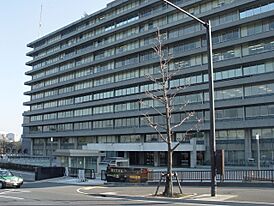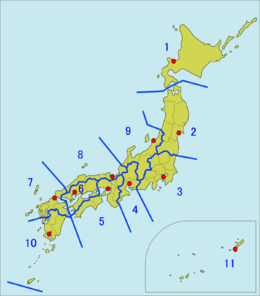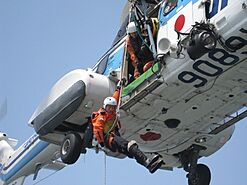Japan Coast Guard facts for kids
Quick facts for kids Japan Coast Guard海上保安庁 Kaijō Hoan-chō |
|
|---|---|

S-Mark
|
|

Japan Coast Guard ensign
|
|
| Abbreviation | JCG |
| Motto | 正義仁愛 Righteous Benevolence |
| Agency overview | |
| Formed | 1948 (as the Maritime Safety Agency) April 2000 (as the Japan Coast Guard) |
| Employees | 13,744 |
| Annual budget | 210,601,000,000 yen |
| Jurisdictional structure | |
| National agency (Operations jurisdiction) |
Japan |
| Operations jurisdiction | Japan |
| Legal jurisdiction | Maritime law enforcement within Japan's EEZ |
| Governing body | Ministry of Land, Infrastructure, Transport and Tourism |
| Operational structure | |
| Headquarters | 2-1-3, Kasumigaseki, Chiyoda-ku, Tokyo 100-8976, Japan 35°40′33″N 139°45′00″E / 35.67583°N 139.75000°E |
| Agency executive |
|
| Child agency |
|
| Facilities | |
| Numbered regions | 11 |
| Ships | 379 |
| Fixed wings | 25 |
| Rotary wings | 46 |
| Website | |
| Official website: https://www.kaiho.mlit.go.jp/index.html Official website: https://www.kaiho.mlit.go.jp/e/index_e.html |
|
The Japan Coast Guard (Japanese: 海上保安庁, Hepburn: Kaijō Hoan-chō) (JCG) is like the police of the sea for Japan. It protects Japan's coastline and waters. The JCG works under the Ministry of Land, Infrastructure, Transport and Tourism. It has about 13,700 people working for it. The Japan Coast Guard started in 1948 as the Maritime Safety Agency. It got its current English name in 2000.
The JCG's motto is "Righteous Benevolence" (正義仁愛 (Seigi Jin'ai)). This means they aim to be fair and kind in their work.
Contents
History of Japan's Sea Protectors
How the Japan Coast Guard Began
Before and during World War II, the Imperial Japanese Navy handled sea protection. After Japan surrendered in 1945, this navy was dissolved. This meant Japan had fewer ways to keep its waters safe.
Because of this, sea trade and smuggling grew a lot. There were even pirates appearing. Japan wanted to make its waters safe again quickly. In 1946, a special group was set up to control illegal immigration. This happened after smugglers brought a serious illness to Japan.
The Allied forces, who were helping Japan after the war, also saw the problem. In 1946, a US Coast Guard captain suggested creating a full coast guard. So, in 1948, the Maritime Safety Agency (MSA) was formed. Its English name changed to the Japan Coast Guard in April 2000.
Clearing Mines After the War
After World War II, many sea mines were left in Japan's waters. Clearing these mines was a very important job for the MSA. Old minesweeper ships from the former Japanese Navy were used for this task. These ships later moved to another defense force.
In 1950, MSA minesweepers even went to the Korean Peninsula. They helped clear mines there under the United Nations flag during the Korean War.
Working with Other Countries
In 1999, Japan's Prime Minister suggested working with countries in Southeast Asia. The idea was for the Japan Coast Guard to patrol waters with other countries. This would help fight piracy and improve safety at sea.
Some countries liked the idea, but others were not so sure. Still, in 2001, armed Japan Coast Guard ships went to other countries. They helped train maritime forces in India, Thailand, and the Philippines to fight piracy. More countries joined these training exercises later.
The 118 Emergency Number
In May 2000, the Japan Coast Guard started a special emergency phone number: 118. You can dial this number from any phone in Japan. It's for reporting accidents at sea, oil spills, or suspicious ships. It's also for reporting smuggling and illegal immigration. In 2018, over 5,000 calls were made about sea accidents.
Important Events: Sea Battles and Collisions
Battle of Amami-Ōshima
On December 22, 2001, Japan Coast Guard ships stopped a vessel in Japanese waters. This ship was believed to be from North Korea. When the vessel did not respond, the JCG ships fired at it. The unknown ship fired back and then sank.
Later, the Japan Coast Guard brought the sunken ship up from the sea. They found weapons and spy equipment on board. The ship and its contents are now on display at the Japan Coast Guard Museum in Yokohama.
Haneda Airport Collision
On January 2, 2024, a Japan Coast Guard plane crashed. It was a DHC-8 'Mizunagi 1' aircraft. The plane was helping with relief efforts after an earthquake. It collided with a Japan Airlines plane at Tokyo's Haneda Airport. Sadly, five Coast Guard crew members died, and one was badly hurt.
What the Japan Coast Guard Does
The main job of the Japan Coast Guard is to keep the seas safe and secure. Here are their key tasks:
- Enforcing laws at sea: They act like police on the water, making sure rules are followed.
- Search and rescue: They help people in trouble at sea and respond to disasters.
- Mapping the ocean: They survey the seafloor and ocean currents to create maps.
- Managing sea traffic: They help guide ships to prevent accidents.
The Japan Coast Guard is a civilian group, not a military one. But they do have important jobs for border security. In emergencies, the Japan Maritime Self-Defense Force (JMSDF), which is Japan's navy, can help the JCG. The Minister of Defense can even give orders to the JCG in such cases.
How the Japan Coast Guard is Organized
National Headquarters and Training
The Japan Coast Guard is led by a Commandant and two Vice Commandants. Other officers include directors and inspectors. The main office is in Tokyo.
The JCG also has special schools to train its members:
- Japan Coast Guard Academy in Kure: This is a four-year school for future officers. Students earn a bachelor's degree. About 40 cadets graduate each year.
- Coast Guard School in Maizuru: This school trains other JCG personnel.
- There are also branch schools in Moji and Miyagi.
Regional Operations Across Japan
The JCG divides Japan into eleven regions. Each region has a main headquarters. Under these headquarters are smaller offices, stations, and air stations. They also have centers for mapping and traffic advice. This helps them cover all of Japan's waters effectively.
| Local Bureaus | Headquarters Location | Region of Responsibility |
|---|---|---|
| 1st Regional Coast Guard Headquarters | Otaru, Hokkaido | Hokkaido, Northern Territories |
| 2nd Regional Coast Guard Headquarters | Shiogama, Miyagi | Aomori, Iwate, Miyagi, Akita, Yamagata, Fukushima |
| 3rd Regional Coast Guard Headquarters | Yokohama, Kanagawa | Ibaraki, Tochigi, Gunma, Saitama, Chiba, Tokyo, Kanagawa, Yamanashi, Shizuoka |
| 4th Regional Coast Guard Headquarters | Nagoya, Aichi | Gifu, Aichi, Mie |
| 5th Regional Coast Guard Headquarters | Kobe, Hyogo | Shiga, Kyoto (south of Nantan City), Osaka, Hyogo (Seto Inland Sea side), Nara, Wakayama, Tokushima, Kochi |
| 6th Regional Coast Guard Headquarters | Hiroshima, Hiroshima | Okayama, Hiroshima, Yamaguchi (Seto Inland Sea side east of Yamaguchi City), Kagawa, Ehime |
| 7th Regional Coast Guard Headquarters | Kitakyushu, Fukuoka | Yamaguchi (Seto Inland Sea side and Sea of Japan side west of Ube City), Fukuoka, Saga, Nagasaki, Oita (also in charge of the Ariake Sea in Kumamoto Prefecture) |
| 8th Regional Coast Guard Headquarters | Maizuru, Kyoto | Kyoto (north of Kyōtamba), Fukui, Hyogo (Sea of Japan side), Tottori, Shimane (including Takeshima) |
| 9th Regional Coast Guard Headquarters | Niigata, Niigata | Niigata, Toyama, Ishikawa, Nagano (also in charge of Sea of Japan side of the Tohoku region) |
| 10th Regional Coast Guard Headquarters | Kagoshima, Kagoshima | Kumamoto (not including the Ariake Sea), Miyazaki, Kagoshima |
| 11th Regional Coast Guard Headquarters | Naha, Okinawa | Okinawa (including the Senkaku Islands) |
Special Teams for Tough Jobs
The JCG has three special teams for very specific and difficult tasks:
- Special Rescue Team (SRT): These are highly trained Rescue swimmers and divers. They rescue people in dangerous situations at sea.
- National Strike Team (NST): This team handles big oil spills and chemical dangers at sea. They are like a specialized cleanup crew.
- Special Security Team (SST): This is a tactical team that deals with terrorism and other serious threats.
Equipment of the Japan Coast Guard
Vessels: Ships and Boats
When the JCG first started, it used old ships from the former Japanese Navy. Over time, they began building their own ships. These new ships were designed to fit Japan's needs and sea conditions better. They have different sizes for different jobs, like large patrol ships (PL), medium patrol ships (PM), and smaller patrol craft (PC).
As sea areas that countries could claim grew, the JCG needed more and bigger ships. They built many new patrol vessels and also started putting helicopters on some of their larger ships. More recently, they have built faster ships and added advanced weapons to deal with modern threats.
The JCG has expanded its facilities on Ishigaki Island. This allows 12 large patrol vessels to be based there. This makes Ishigaki the JCG's biggest base.
Number of Vessels
The JCG operates 454 watercraft. These include:
- Patrol vessels: 146
- Patrol craft: 239
- Special guard and rescue craft: 49
- Hydrographic survey vessels: 15
- Aids to navigation evaluation vessels: 1
- Buoy tenders: 5
- Aids to navigation tenders: 18
- Training boats: 3
Aircraft: Planes and Helicopters
The JCG uses aircraft to help with its missions, especially for search and rescue. They have both fixed-wing planes and helicopters.
Number of Aircraft
The JCG operates 95 aircraft. These include:
- Fixed wing planes: 36
- Helicopters: 59
-
Eurocopter AS332 Super Puma of the JCG
Vehicles on Land

The JCG uses civilian vans and minibuses. These vehicles transport goods and personnel. They also transport people who have been caught breaking laws, like illegal immigrants.
Armaments: Weapons Used
Weapons on Vessels
At first, JCG ships could only carry small weapons. But after the Korean War, they were allowed to have larger guns. They started with 3-inch guns and 40 mm guns on bigger ships. Smaller ships had 20 mm guns.
Over time, these older guns were replaced with newer, more advanced ones. Modern JCG ships have guns that can be controlled remotely. They can also automatically track targets. This helps them shoot more accurately. Some ships now have powerful 40 mm or 30 mm chain guns. These are used to counter heavily armed vessels.
Personal Weapons for Officers
In the early days, JCG officers used old pistols and rifles from World War II. In the 1960s, they got new revolvers. Some special security units now use modern pistols.
Their rifles were also updated over the years. Today, officers use modern automatic rifles. The Special Security Team (SST) also has submachine guns and sniper rifles for special operations.
Japan Coast Guard Museums
You can learn more about the Japan Coast Guard at these museums:
- Japan Coast Guard Museum in Kure, Hiroshima Prefecture.
- Japan Coast Guard Museum Yokohama in Naka-ku, Yokohama, Kanagawa Prefecture.
- NYK Maritime Museum in Yokohama, which also covers Japan's sea history.
See also
- Japan Coast Guard Academy
- Big Joys, Small Sorrows
- Umizaru
- Umizaru 2: Test of Trust
- North Pacific Coast Guard Agencies Forum
- DAICHI (ALOS)











